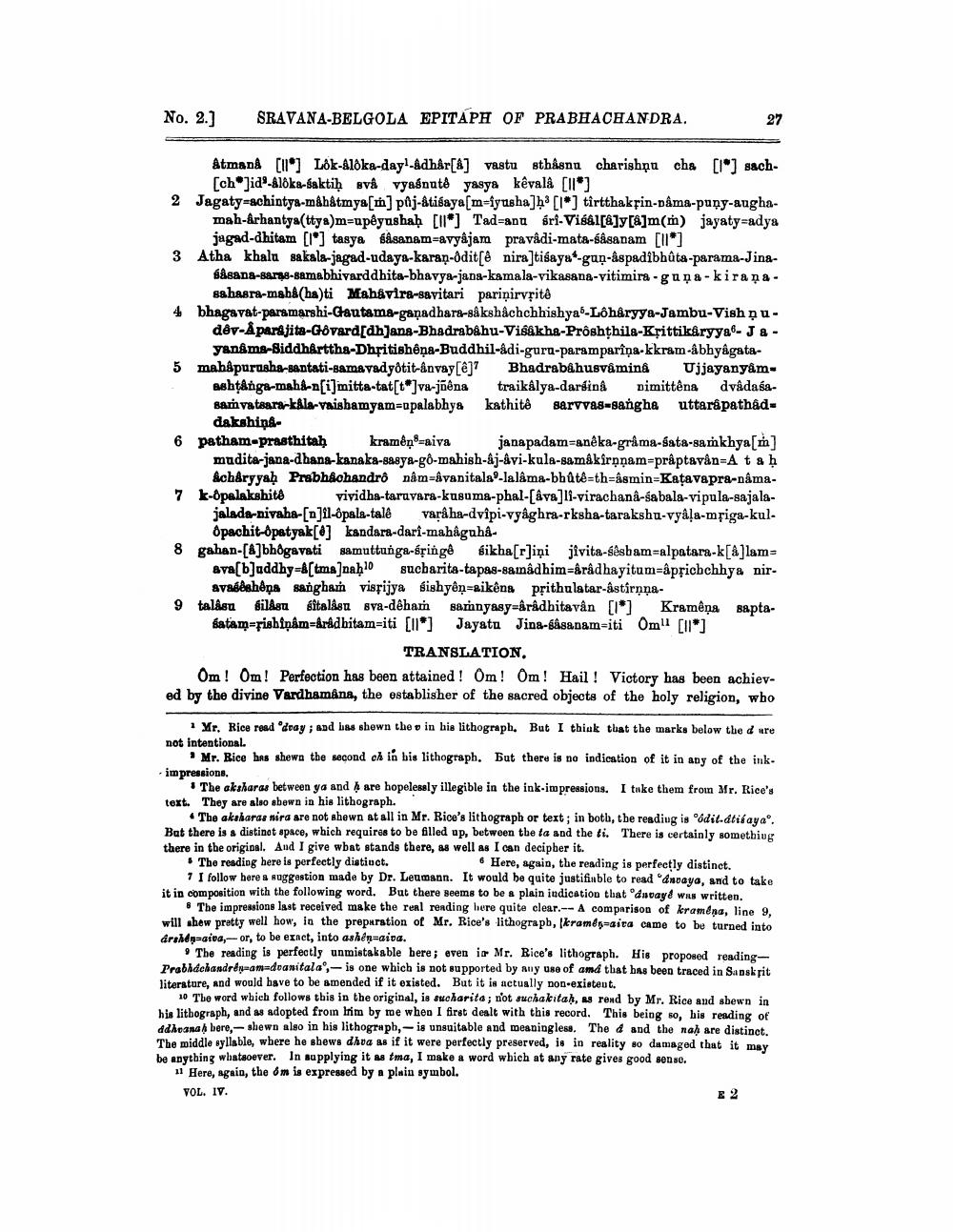________________
No. 2.)
SRAVANA-BELGOLA EPITAPH OF PRABHACHANDRA.
27
Atmana [ll] Lôk-Aloka-day-Adhår[&] vastu sthåsnu charishņu cha [*] sach
[ch]id-Aloka-saktiḥ svá vyaśnutd yasya kêvala [11*] 2 Jagaty=achintya-mahatmya[m] paj-atifaya[m-iyusha]": [l) tirtthakfin-dâma-puny-augha
mah-århantya(ttya)m=upéyushaḥ [11*] Tad=anu sri-Visa1[@]y[&]m(m) jayaty=adya
jagad-dhitam [l*) tasya bisanam=avyajam pravådi-mata-śâsanam [ll"] 3 Atha khala sakala-jagad-udaya-karan-8dit[& nira]tiśayat-gan-aspadîbhûta-parama-Jina
Sâsana-arx8-samabhivarddhita-bhavya-jana-kamala-vikasana-vitimira -guna-kirana
Bahasra-mah&(ha)ti Mahåvira-savitari pariņirvșitë 4 bhagavat-paramarshi-Gautama-gañadhara-såkshåchchhishya-Lô håryya-Jambu-Vishnu
dôv-Åparajita-Govard[dh]ana-Bhadrabahu-Visakha-Proshthila-Krittikäryya - J & -
yanama-Siddharttha-Dhritishêņa-Buddhil-adi-gura-parampariņa-kkram-abhyagata5 mah&purusha-santati-samavadyotit-anvaysel? Bhadrabahusvämina Ujjayanyám
ashtånga-mahd-n[i]mitta-tat[t]va-jñêna traikálya-dardina dimittêna dvadasasamvatsara kåla-vaisbamyam=opalabhya kathitê sarvvas=sanghe uttarapathade
dakshina 6 patham-prasthitah kramêņ8-aiva janapadam-aneka-gråma-sata-samkhya[m]
mudita-jana-dhana-kanaka-sasya-gô-mahish-aj-avi-kula-samakirņņam=prâptavan=A taḥ
Acheryyah Prabhachandrð nám=&vapitala-lalåma-bható-th=Asmin=Katavapra-nâma7 k-Opalaksbito vividha-taruvara-kusuma-phal-Cava]li-virachana-sabala-vipula-sajala
jalada-nivaha-[n]il-Opala-tale varkha-dvipi-vyāghra-rksha-tarakshu-vyaļa-mpiga-kul.
Opachit-patyak[0] kandara-dari-mahagaha8 gahan-[6]bhôgavati samuttunga-śpingê sikha[r]iņi jivita-sêsbam-alpatara-k[A]lam=
Ava[b]uddhy=&[tma]nah sucharita-tapas-sainadhim=&râdhayitum=&prichchhya nir
avasëshồna sangham vispijya sishyên=aikêng prithulatar-astirņņa9 talásu filsu sitelåsu sya-dêham samnyasy=&rådbitavan [lo] Kramêņa saptaSatam-fishiņám=&radbitam=iti [118] Jayatu Jina-âsanam=iti Om![11*]
TRANSLATION. Om ! Om! Perfection has been attained ! Om! Om! Hail ! Victory has been achieved by the divine Vardhamana, the establisher of the sacred objects of the holy religion, who
1 Mr. Rice road duay, and has shown theo in his lithograph. But I think that the marks below the dure not intentional
Mr. Rice has shewn the second ch in his lithograph. But there is no indication of it in any of the ink. impressions,
The aksharas between ya and are hopelessly illegible in the ink-impressions. I take them from Mr. Rice's text. They are also sewn in his lithograph.
The akaharae mira are not shewn at all in Mr. Rico's lithograph or text; in both, the reading is dit.dtisayao. Bat there is a distinot space, which requires to be filled up, between the ta and the bi. There is certainly something there in the original. And I give wbat stands there, 48 well as I can decipher it. * The reading here is perfectly distiuct.
6 Here, again, the reading is perfectly distinct. 1 I follow here a suggestion made by Dr. Leumann. It would be quite justifiable to read ancaya, and to take it in composition with the following word, But there seems to be a plain indication that odavayê was written.
The impressions last received make the real reading here quite clear.-- A comparison of kramana, line 9, will show pretty well how, in the preparation of Mr. Rice's lithograpb, ikramdgwaita came to be turned into drahép=aiva, or, to be exact, into ashén=aiva.
The reading is perfectly unmistakable bere; even in Mr. Rice's lithograph. His proposed readingPrabadehandrdgamedoanitala',- is one which is not supported by any use of amd that has been traced in Sanskrit literature, and would bave to be amended if it existed. But it is actually non-existent.
10 The word which follows this in the original, is sucharita; not suchakitah, as rend by Mr. Rice and sewn in his lithograph, and as adopted froin Inm by me when I first dealt with this record. This being so. his reading of ddhoanah bere, shewn also in his lithograph,-is unsuitable and meaningless. The d and the nah are distinct. The middle syllable, where he shews dhva as if it were perfectly preserved, is in reality so damaged that it may be anything whatsoever. In supplying it as tma, I make a word which at any rate gives good senso.
11 Here, again, the êm is expressed by a plain symbol. VOL. IV.




